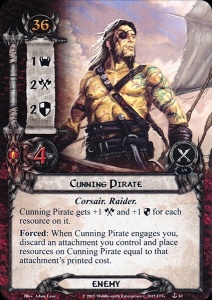Today it’s time for one of my (very) occasional articles. I will be a (mostly) rant-free discussion. This article, like Lord of the Rings, is meant to be the story of a journey. Our quest to rediscover the fun of Lord of the Rings the Card Game.
The Task
I decided that I wanted to work through a full campaign. My wife wanted something set in Gondor or Arnor, which confronting either the Heirs of Numenor (need mono-sphere and the ability to tackle siege/battle questing) or Carn Dum (a definite top-five contender for worst quest ever). I decided to go for Arnor, as Carn Dum is a fair way down the line, and by then we would either have figured things out well enough to make a creditable attempt, or given up.
Taking the Hobbits to Angmar (mar, mar, mar)

Don’t be hasty
The next task was to build decks. The only original/recently-built deck I had, was a Hobbit/Ent deck – Black Riders Merry & Pippin + Folco, with Folco being there to offer early resources then, if necessary, drop threat so that you can avoid enemies long enough to get a board full of Ents established (Treebeard being the most important). For a cycle like Angmar Awakened, I wasn’t at all convinced that would work – it was too slow, and the heroes had too few hit-points. Still, I figured I’d test it out.
Playing on Easy mode, I managed to get Treebeard and a Booming Ent out on turn 1 – knowing I didn’t need to make any optional engagements, I quested with everyone for 7. I revealed a side quest, losing Iarion, but made a single progress. Turn 2, more Ents in play, Treebeard and the Booming Ent ready – then I got a treachery that revealed another card for each quest in play (2), then drew a location, an Angmar Orc (when revealed: discard an ally from play or reveal another card) then another one. Then yet another enemy. Despite questing with all my heroes and an ally, I’d failed questing by 6!
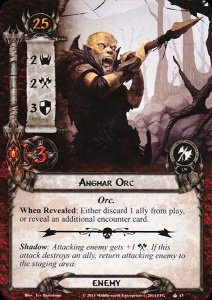 The Angmar Orc is a great example of how the game has skewed so badly in recent years. For one thing, he’s a hefty enemy – 3 hit points, 3 defence is no joke – Treebeard was the only character who could even damage him on his own. In any of the early cycles, those stats alone would be plenty for the card to contain. Now though, he comes with this pseudo-surge effect: previously surge like this was for flimsy little goblins only. “Easy” mode is anything but.
The Angmar Orc is a great example of how the game has skewed so badly in recent years. For one thing, he’s a hefty enemy – 3 hit points, 3 defence is no joke – Treebeard was the only character who could even damage him on his own. In any of the early cycles, those stats alone would be plenty for the card to contain. Now though, he comes with this pseudo-surge effect: previously surge like this was for flimsy little goblins only. “Easy” mode is anything but.
The Orc War Party, who are the centre-piece of this quest, prevent enemies in the staging area from being damaged, which meant that there was no point even trying my Direct Damage deck (Thalin, Argalad, Beregond), as too many of the features simply wouldn’t work. I was left with a choice of either trying out my Silvan/Victory Display fellowship, or trying to build a new pair of decks.
Where Now are the Dunedain?
I needed something that could handle lots of enemies – realistically that meant a Dunedain deck – Aragorn, Amarthiul, Halbarad, Mablung (not a Dunedan, but fits the archetype well). Then I would need a support deck, something that could quest a lot, and could heal (ideally with card draw and threat control as a bonus). Elrond and Glorfindel + someone seemed a good fit here (Elrond for healing, Glorfindel for low threat, both give access to powerful Noldor cards, and you can get Asfaloth, Vilya etc). Amarthiul appears in objective ally form in several of the quests in this cycle, so I ruled him out.
 In the end, I created a completely illegal, but fun-looking fellowship that I called “The Once and Future King” – A Halbarad/Mablung/Tactics Aragorn deck on one side, and an Elrond/Spirit Glorfindel/ Lore Aragorn deck on the other. Rather than include them here, you can find the Fellowship on Rings DB.
In the end, I created a completely illegal, but fun-looking fellowship that I called “The Once and Future King” – A Halbarad/Mablung/Tactics Aragorn deck on one side, and an Elrond/Spirit Glorfindel/ Lore Aragorn deck on the other. Rather than include them here, you can find the Fellowship on Rings DB.
Both of the decks struggled a bit with card draw, and there were definitely issues getting some of the key cards (I really needed Song of Kings, as Mablung racked up an ever-bigger stack of cash, and I only found Leadership cards to play).
I’d used Sword that was Broken in Dunedain decks in the past, but found it really hard to get out cost-wise, and that I wasn’t sending enough people to the quest to make it worthwhile. For this fellowship, adding it to Loragorn meant that the Willpower boost was typically a lot more effective/worthwhile, even though it’s still hard to afford early on.
Raiment of War (for Vigilant Dunedain) – 6 is a lot of resources, but you get a 3 defence, 5 hit-point, non-exhausting enemy (that can be healed)
The version here is more-or-less what I used from Deadman’s Dyke onwards. Early drafts had more mounts and fewer weapons, but this just felt a bit easier to leverage.
Beginng the Campaign
The first two quests – Intruders in Chetwood and the Weather Hills – saw a fair amount of chopping and changing on our part, as we got used to the rhythm of the decks.
 One thing I did notice about ‘Easy Mode’ is how thick and fast the side quests come. This was the first box to feature side quests, so there were quite a lot of them anyway but, as none of them get removed when filtering out the non-easy cards, the concentration is quite high early on, making the Encounter Cards that are X “Where X is the number of quest cards in play” particularly nasty. However, that also means that, once you’ve weathered the early assault, you’re probably fairly well set, as most of the really game-wrecking treacheries have been removed.
One thing I did notice about ‘Easy Mode’ is how thick and fast the side quests come. This was the first box to feature side quests, so there were quite a lot of them anyway but, as none of them get removed when filtering out the non-easy cards, the concentration is quite high early on, making the Encounter Cards that are X “Where X is the number of quest cards in play” particularly nasty. However, that also means that, once you’ve weathered the early assault, you’re probably fairly well set, as most of the really game-wrecking treacheries have been removed.
Continuing the Journey
 The next steps went well too – we cleared Deadman’s Dyke, and the first quest of the cycle proper, Wastes of Eriador. I’m still not a fan of Wastes – it has an annoying feature where every other round it’s night and you can’t place progress on any quest, plus an incredibly irritating treachery that suddenly makes it night mid-way through the quest phase. Fortunately, in “Easy Mode” you can survive the extra rounds (there is still A LOT of combat, and the Wardens of Healing + Elrond’s effect were working overtime), and we got out the other side in one piece.
The next steps went well too – we cleared Deadman’s Dyke, and the first quest of the cycle proper, Wastes of Eriador. I’m still not a fan of Wastes – it has an annoying feature where every other round it’s night and you can’t place progress on any quest, plus an incredibly irritating treachery that suddenly makes it night mid-way through the quest phase. Fortunately, in “Easy Mode” you can survive the extra rounds (there is still A LOT of combat, and the Wardens of Healing + Elrond’s effect were working overtime), and we got out the other side in one piece.
Getting out of Here
Escape from Mount Gram is probably the quest I know best in this cycle, I haven’t started it quite as many times as Battle of Carn Dum, but a lot of that is down to the fact that it’s (broadly) an easier quest), at least for solo play. For anyone not familiar with it, this quest is basically a prison break – all your allies, mounts, items and artifacts are taken away, and you need to get out of the dungeon despite starting with only a single hero, and whatever was left of your deck (generally events and condition attachments).
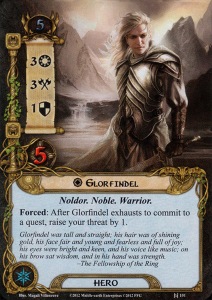
Looks like you’re on your own
One of the biggest challenges of this scenario was the way it splits your party up – the Elf deck was alright starting with Glorfindel only, particularly with a decent chance of drawing into Light of Valinor and/or Unexpected Courage early on, but solo Halbarad is a different proposition altogether: on our first attempt, I had to engage a couple of enemies to avoid the staging area getting completely gridlocked, and then got killed by a nasty shadow card or 2. Second time round, things went a bit better: I was still mostly just treading water, but managed to survive long enough to team up with the elves. A lot of cards in this scenario have the “capture” mechanic, with some of the cards that were taken away from you at the start being hidden underneath them and returned to your hand (or sometimes directly to play) when that card is dealt with. By the time we joined together, Elrond and Glorfindel, were backed up by Arwen, Yazan, Gildor, a stargazer and a healer!
The Dunedain came good in the end, managing to 1-shot the boss enemy as we burst out of the dungeon. Victory at the second attempt, and onto the next.
There’s Moor!
Once you make it out of Mount Gram, you need to head Across the Ettenmoors, where you will find a lot of trolls. It’s a quest I’ve only played once or twice, notorious for being the pack which gave us the truly dreadful Hero Dori.
This is an odd quest, and re-playing it didn’t massively alter my feelings in that regard – Stage 1 forces you to have a side quest in play every round, and as mentioned already, the side-quests come pretty thick and fast in Easy Mode anyway. By the end of the game, we’d cleared out the full set of side quests, and with only a limited number of enemies in the deck, it was just a case of surviving until the side-quests had been cleared, then a fairly easy move to the end.
 After the Ettenmoors, came the Treachery of Rhudaur – this is very much a momentum quest, with a hard-cap 5-round time-limit on stage 1, as you try to collect various side-quests which turn into objective-attachment rewards. This was definitely a quest where the easy-mode set-up made a big difference, and even though there were points where we got a bit swamped by enemies, we got all 3 objectives, and completed the quest fairly comfortably.
After the Ettenmoors, came the Treachery of Rhudaur – this is very much a momentum quest, with a hard-cap 5-round time-limit on stage 1, as you try to collect various side-quests which turn into objective-attachment rewards. This was definitely a quest where the easy-mode set-up made a big difference, and even though there were points where we got a bit swamped by enemies, we got all 3 objectives, and completed the quest fairly comfortably.
Battles lost and… lost
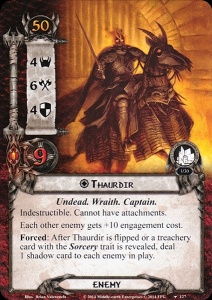 The penultimate quest in this cycle is The Battle of Carn Dum. Quite possibly the worst quest ever designed for the game. Being tortured by Nazgul who want you to surrender the location of the one ring is probably quite pleasant in comparison.
The penultimate quest in this cycle is The Battle of Carn Dum. Quite possibly the worst quest ever designed for the game. Being tortured by Nazgul who want you to surrender the location of the one ring is probably quite pleasant in comparison.
For a 2-player game, you start with a 4-threat boss enemy in the staging area, a 2-threat location, and 2 1-threat* enemies. (so, that’s 8).
 Carn Dum does a lot of playing with Shadow cards: the “1-threat” enemies get +1 threat for each shadow card they have. The boss enemy deals a shadow card to each enemy in play every time a treachery with the Sorcery keyword is revealed. So, each sorcery treachery is cranking the threat up by 2, as well as its effect (and some have surge). Shadow Cards in Carn Dum are only discarded once they are resolved, so as long as these sit in the staging area, the threat is just going up and up.
Carn Dum does a lot of playing with Shadow cards: the “1-threat” enemies get +1 threat for each shadow card they have. The boss enemy deals a shadow card to each enemy in play every time a treachery with the Sorcery keyword is revealed. So, each sorcery treachery is cranking the threat up by 2, as well as its effect (and some have surge). Shadow Cards in Carn Dum are only discarded once they are resolved, so as long as these sit in the staging area, the threat is just going up and up.
Of course, you can engage the enemies to avoid their threat – but at 4 attack, 3 defence and 5 hit points, you’re likely to take significant damage, and probably won’t kill it in a single round.
I haven’t crunched the numbers, but I think realistically you’re looking at having at least 12 threat to quest against in round 1, as well as having to take on at least an enemy each (and a big one at that).
Every few rounds, the boss enemy is going to get up to having 3 shadow cards on him, at which point he flips, makes an immediate attack against the first player, and suddenly lowers the engagement cost of every other enemy in play by 10, at which point you get swarmed by anything that hasn’t engaged you already.
We played this 3 times, not coming close to beating it on any occasion.
The point of this exercise was to play through a full cycle with a pair of decks – I’ve made tweaks as we go along, and certainly wouldn’t mind making a few more. But there’s a difference between tweaking and completely custom-building new decks, and I just can’t see any version of these decks beating the quest. Given that the other point of this whole activity was to have some fun, I decided to just give up and move on…
The Final Battle
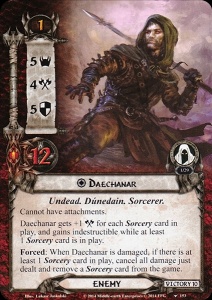 Final scenario in the cycle is The Dread Realm – we definitely had to grapple with this one, taking a long time to get anywhere. The big new thing, is face-down cards from players decks (or occasionally their discard piles) being “reanimated” as 2-2-2-2 undead enemies – there are lots of effects that will reanimate more cards, and other cards which key off of it, so this is a fairly major thing to deal with. Once you get through the early part of the game, there is also a fairly nasty end-of-campaign boss in Daechanar (an evil spirit who has stolen the body of your kidnapped friend who you have spent the campaign trying to rescue). He gets +1 attack for every sorcery card in play (there are various treacheries with this keyword that turn into attachments), and cannot be damaged whilst these are in play – instead you remove a Sorcery card from the game for each instance of damage: as there’s a chance that more sorcery will be churned out every round, you need multiple ways to damage him each round to be able to take him down.
Final scenario in the cycle is The Dread Realm – we definitely had to grapple with this one, taking a long time to get anywhere. The big new thing, is face-down cards from players decks (or occasionally their discard piles) being “reanimated” as 2-2-2-2 undead enemies – there are lots of effects that will reanimate more cards, and other cards which key off of it, so this is a fairly major thing to deal with. Once you get through the early part of the game, there is also a fairly nasty end-of-campaign boss in Daechanar (an evil spirit who has stolen the body of your kidnapped friend who you have spent the campaign trying to rescue). He gets +1 attack for every sorcery card in play (there are various treacheries with this keyword that turn into attachments), and cannot be damaged whilst these are in play – instead you remove a Sorcery card from the game for each instance of damage: as there’s a chance that more sorcery will be churned out every round, you need multiple ways to damage him each round to be able to take him down.
We got there in the end, but it was a bit of a slog, and we felt pretty exhausted by the end.
Final Thoughts
As I said at the start, this campaign was about trying to recapture the fun of this game, and overall I think it succeeded. In some instances “easy” mode definitely was easy, and I wouldn’t have minded a bit more of a challenge, but there were plenty of other times when it was still tough, and at least one scenario (Carn Dum) that remained stupid and broken.
I like this approach to the game – building a pair of decks and trying to take them through a broader sweep of scenarios. Inevitably, I think that’s going to need to still be on Easy Mode, because I don’t want to have to micro-tweak the deck before/after each and every scenario. I no longer promise/threaten regular content updates on this blog, but I might post periodic threads like this if the content presents itself.
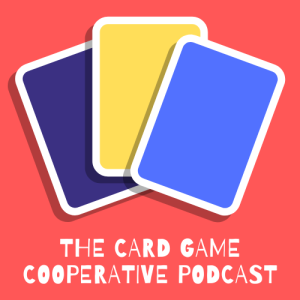 Along with a few friends, I have just launched “The Card Game Cooperative” – a podcast about Lord of the Rings LCG, Arkham Horror LCG, and the new Marvel Champions LCG.
Along with a few friends, I have just launched “The Card Game Cooperative” – a podcast about Lord of the Rings LCG, Arkham Horror LCG, and the new Marvel Champions LCG.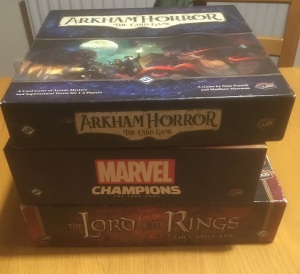 (As well as the direct link above, you can find us on Spotify and hopefully soon on iTunes/Apple Podcast)
(As well as the direct link above, you can find us on Spotify and hopefully soon on iTunes/Apple Podcast)

 The Angmar Orc is a great example of how the game has skewed so badly in recent years. For one thing, he’s a hefty enemy – 3 hit points, 3 defence is no joke – Treebeard was the only character who could even damage him on his own. In any of the early cycles, those stats alone would be plenty for the card to contain. Now though, he comes with this pseudo-surge effect: previously surge like this was for flimsy little goblins only. “Easy” mode is anything but.
The Angmar Orc is a great example of how the game has skewed so badly in recent years. For one thing, he’s a hefty enemy – 3 hit points, 3 defence is no joke – Treebeard was the only character who could even damage him on his own. In any of the early cycles, those stats alone would be plenty for the card to contain. Now though, he comes with this pseudo-surge effect: previously surge like this was for flimsy little goblins only. “Easy” mode is anything but. In the end, I created a completely illegal, but fun-looking fellowship that I called
In the end, I created a completely illegal, but fun-looking fellowship that I called  One thing I did notice about ‘Easy Mode’ is how thick and fast the side quests come. This was the first box to feature side quests, so there were quite a lot of them anyway but, as none of them get removed when filtering out the non-easy cards, the concentration is quite high early on, making the Encounter Cards that are X “Where X is the number of quest cards in play” particularly nasty. However, that also means that, once you’ve weathered the early assault, you’re probably fairly well set, as most of the really game-wrecking treacheries have been removed.
One thing I did notice about ‘Easy Mode’ is how thick and fast the side quests come. This was the first box to feature side quests, so there were quite a lot of them anyway but, as none of them get removed when filtering out the non-easy cards, the concentration is quite high early on, making the Encounter Cards that are X “Where X is the number of quest cards in play” particularly nasty. However, that also means that, once you’ve weathered the early assault, you’re probably fairly well set, as most of the really game-wrecking treacheries have been removed. The next steps went well too – we cleared
The next steps went well too – we cleared 
 After the Ettenmoors, came the
After the Ettenmoors, came the  The penultimate quest in this cycle is
The penultimate quest in this cycle is  Carn Dum does a lot of playing with Shadow cards: the
Carn Dum does a lot of playing with Shadow cards: the  Final scenario in the cycle is
Final scenario in the cycle is 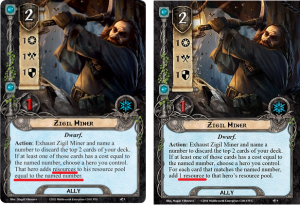 We have a couple of new-ish players of LotR coming to our monthly meet-up at the FLGS – they’ve probably been coming along for 9 months (although I’m notoriously bad at time-frames), and are still picking up the cards. A little while back, we noticed that 2 of us have copies of Zigil Miner in play – except that mine comes from when Khazad Dum was originally printed in 2011, his was a reprint 6 years later- now we’ve got 2 copies of the same card, that have different abilities.
We have a couple of new-ish players of LotR coming to our monthly meet-up at the FLGS – they’ve probably been coming along for 9 months (although I’m notoriously bad at time-frames), and are still picking up the cards. A little while back, we noticed that 2 of us have copies of Zigil Miner in play – except that mine comes from when Khazad Dum was originally printed in 2011, his was a reprint 6 years later- now we’ve got 2 copies of the same card, that have different abilities. For a co-op game though, that’s not the case. If a card is making the game too easy for you– DON’T USE IT! I’d be amazed if even 1% of LotR time is organised play, these changes just aren’t needed.
For a co-op game though, that’s not the case. If a card is making the game too easy for you– DON’T USE IT! I’d be amazed if even 1% of LotR time is organised play, these changes just aren’t needed. Someone is boring enough to spend all their resources every round on
Someone is boring enough to spend all their resources every round on  Boromir certainly had potential to get very powerful. However, you still needed lots of threat reduction to use him much, and the really “game-breaking” effects came from people combo-ing him
Boromir certainly had potential to get very powerful. However, you still needed lots of threat reduction to use him much, and the really “game-breaking” effects came from people combo-ing him 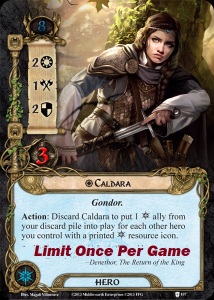 Caldara decks could be a bit bonkers at times, but the only reactions I ever had from people playing opposite it was “wow that’s cool” and “now we can finally beat the stupid quest that’s been stomping on our faces and actually enjoy the game again.”
Caldara decks could be a bit bonkers at times, but the only reactions I ever had from people playing opposite it was “wow that’s cool” and “now we can finally beat the stupid quest that’s been stomping on our faces and actually enjoy the game again.” The last one which really wound me up was We Are Not Idle – a card which could previously gain you a bit of resource acceleration now only triggers off of dwarf heroes, not dwarf characters. Once again, the logic stinks: yes, you can exhaust a million dwarves, get a million resources, and then ready them all with
The last one which really wound me up was We Are Not Idle – a card which could previously gain you a bit of resource acceleration now only triggers off of dwarf heroes, not dwarf characters. Once again, the logic stinks: yes, you can exhaust a million dwarves, get a million resources, and then ready them all with  As a last note on the FAQ, there’s a question of timing. The game has got MUCH harder in recent times, as the designers build quests designed to tax the most powerful of decks. Our enjoyment of Mountain of Fire has been severely curtailed by not being able to get past the first scenario. Probably the way to finally get this to go away would be to throw Caldara at it, but ‘officially’ that’s no longer an option.
As a last note on the FAQ, there’s a question of timing. The game has got MUCH harder in recent times, as the designers build quests designed to tax the most powerful of decks. Our enjoyment of Mountain of Fire has been severely curtailed by not being able to get past the first scenario. Probably the way to finally get this to go away would be to throw Caldara at it, but ‘officially’ that’s no longer an option.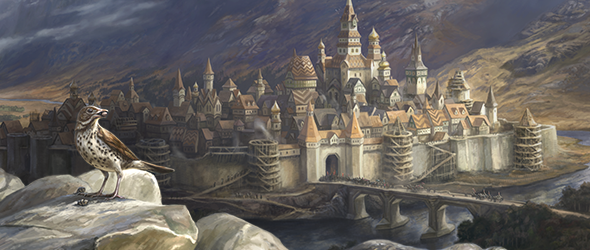
 That said, the expansion didn’t do a great deal to grab me. For one thing, the first two quests: Journey up the Anduin and Lost in Mirkwood look like fairly thinly-veiled re-hashes of the opening Core Set scenarios, except that by now the enemies have trebled in size, and hit for 5, twice in a round.
That said, the expansion didn’t do a great deal to grab me. For one thing, the first two quests: Journey up the Anduin and Lost in Mirkwood look like fairly thinly-veiled re-hashes of the opening Core Set scenarios, except that by now the enemies have trebled in size, and hit for 5, twice in a round. A day later, everything became clear. The Deluxe announcement was just to make sure that people didn’t think the game was dying. Obviously, they do that all the time, but it was probably even more likely in the face of
A day later, everything became clear. The Deluxe announcement was just to make sure that people didn’t think the game was dying. Obviously, they do that all the time, but it was probably even more likely in the face of  All-in-all, it sounded interesting, although I did have a few major concerns. Firstly the platform: it’s Steam only, at least to begin with, which feels odd, as this seems to be a game that’s far more suited to tablet play than sitting down at a PC. The feeling seems to be that Android and iOS will follow, although I’ve not found a concrete source for that (I’ve read all the articles I could find from FFG, but not seen the video of the live-stream where they made the initial announcement).
All-in-all, it sounded interesting, although I did have a few major concerns. Firstly the platform: it’s Steam only, at least to begin with, which feels odd, as this seems to be a game that’s far more suited to tablet play than sitting down at a PC. The feeling seems to be that Android and iOS will follow, although I’ve not found a concrete source for that (I’ve read all the articles I could find from FFG, but not seen the video of the live-stream where they made the initial announcement).
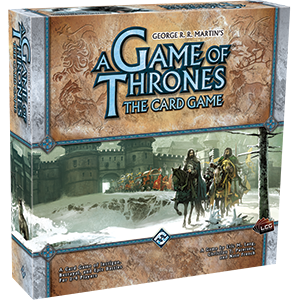 I had come across FFG via their Game of Thrones LCG which, in turn, I had encountered after reading the Song of Ice and Fire novels. When I first discovered AGoT LCG, my Board Gaming was probably limited to a small handful of games – Ticket to Ride, Carcassonne and Settlers, but I had found my way into a local gaming group, and even to a magical place called Board Game Geek.
I had come across FFG via their Game of Thrones LCG which, in turn, I had encountered after reading the Song of Ice and Fire novels. When I first discovered AGoT LCG, my Board Gaming was probably limited to a small handful of games – Ticket to Ride, Carcassonne and Settlers, but I had found my way into a local gaming group, and even to a magical place called Board Game Geek. Pretty much on the day it came out, I went to fetch my first copy of Lord of the Rings the Living Card Game (tbh, I don’t remember the exact date, but 20th April is the date on the release article) – once we got past a few early mistakes (engaged enemies don’t contribute threat to the staging area, apparently!) it was a massive hit. We played the core scenarios to death, and picked up every expansion going – various friends were introduced to the game, and 2 or 3 played it dozens of times with us. We have successfully completed every single scenario in the first 3 cycles and all the Hobbit Sagas in all 4 player counts
Pretty much on the day it came out, I went to fetch my first copy of Lord of the Rings the Living Card Game (tbh, I don’t remember the exact date, but 20th April is the date on the release article) – once we got past a few early mistakes (engaged enemies don’t contribute threat to the staging area, apparently!) it was a massive hit. We played the core scenarios to death, and picked up every expansion going – various friends were introduced to the game, and 2 or 3 played it dozens of times with us. We have successfully completed every single scenario in the first 3 cycles and all the Hobbit Sagas in all 4 player counts
 As I mentioned at the start, today is Lord of the Rings LCG’s 6th Birthday. The game has come a long way from the days of mono-sphere, 30-card decks when we could imagine nothing more terrifying than a Hill Troll. Where once there were only 12 heroes, now there are 80! (plus a handful of Bilbos, Frodos and Aragorns in the Baggins or Fellowship Spheres [it’s not a sphere!]) Beyond the heroes themselves, the possibilities for card combinations in decks is beyond calculation. The same character may appear multiple times, in multiple different guises (although only 1 of them can be in play at a time…)
As I mentioned at the start, today is Lord of the Rings LCG’s 6th Birthday. The game has come a long way from the days of mono-sphere, 30-card decks when we could imagine nothing more terrifying than a Hill Troll. Where once there were only 12 heroes, now there are 80! (plus a handful of Bilbos, Frodos and Aragorns in the Baggins or Fellowship Spheres [it’s not a sphere!]) Beyond the heroes themselves, the possibilities for card combinations in decks is beyond calculation. The same character may appear multiple times, in multiple different guises (although only 1 of them can be in play at a time…)
 As I look to the future, my feeling is that the direction of LotR is not particularly likely to recapture my imagination:
As I look to the future, my feeling is that the direction of LotR is not particularly likely to recapture my imagination:  As most people probably guessed from my last post, I became a father in February. Gaming time is more limited these days – Ned can’t really manage peekaboo yet, so I think LotR will be beyond him for a few years, and blogging time is harder to find as well. Lord of the Rings is already competing against Arkham, Zombicide, Pathfinder, Aeon’s End, Elder Sign, Marvel Legendary, Destiny, Dice Masters, and Mansions of Madness to name but a few, even before I decide whether to get into Runewars, Gloomhaven or Legend of the Five Rings. Honestly I can’t see myself getting back to a position any time soon where I’m spending enough time on Lord of the Rings to warrant writing a blog about it.
As most people probably guessed from my last post, I became a father in February. Gaming time is more limited these days – Ned can’t really manage peekaboo yet, so I think LotR will be beyond him for a few years, and blogging time is harder to find as well. Lord of the Rings is already competing against Arkham, Zombicide, Pathfinder, Aeon’s End, Elder Sign, Marvel Legendary, Destiny, Dice Masters, and Mansions of Madness to name but a few, even before I decide whether to get into Runewars, Gloomhaven or Legend of the Five Rings. Honestly I can’t see myself getting back to a position any time soon where I’m spending enough time on Lord of the Rings to warrant writing a blog about it.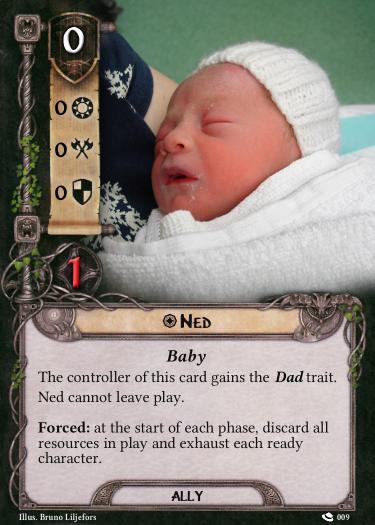

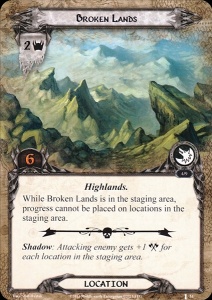 One of the few encounter sets which did show up repeatedly, was Broken Lands. First appearing in the Second Scenario, To Catch an Orc, it had 3 copies of 1 hideous location, the eponymous Broken Lands themselves. Whilst they only had 2 threat, they were a chunky 6 progress to explore, and has a passive effect which prevented progress being placed on locations in the staging area whilst they were in the staging area. The rest of the locations in that scenario were, actually, not that huge (average threat/progress of 3), but there was one – Methedras – which boosted the threat of all the others, and things could swiftly get out of control. Essentially, once you drew Broken Lands, you had to travel and clear it, before you drew another copy – in high-player counts, an early one of these basically meant instant location-lock.
One of the few encounter sets which did show up repeatedly, was Broken Lands. First appearing in the Second Scenario, To Catch an Orc, it had 3 copies of 1 hideous location, the eponymous Broken Lands themselves. Whilst they only had 2 threat, they were a chunky 6 progress to explore, and has a passive effect which prevented progress being placed on locations in the staging area whilst they were in the staging area. The rest of the locations in that scenario were, actually, not that huge (average threat/progress of 3), but there was one – Methedras – which boosted the threat of all the others, and things could swiftly get out of control. Essentially, once you drew Broken Lands, you had to travel and clear it, before you drew another copy – in high-player counts, an early one of these basically meant instant location-lock. Easily my favourite scenario of this cycle was Trouble in Tharbad – it got a bit of stick when it came out (especially from some of the power-gamers) for being too easy, but in my book, that was a significant part of its charm: this was a scenario that allowed enough scope for players to try different things out, rather than just charging full-tilt with an aggro deck at everything. (it’s worth remembering that this is around the time that the One-Boromir-to-rule-them-all deck first came to prominence).
Easily my favourite scenario of this cycle was Trouble in Tharbad – it got a bit of stick when it came out (especially from some of the power-gamers) for being too easy, but in my book, that was a significant part of its charm: this was a scenario that allowed enough scope for players to try different things out, rather than just charging full-tilt with an aggro deck at everything. (it’s worth remembering that this is around the time that the One-Boromir-to-rule-them-all deck first came to prominence). The trouble with Tharbad is that it was followed up immediately with the absolute slog that is Nin-in-Eilph. The positive about this quest, is that it captured very well the feeling of trudging around in a swamp whilst hopelessly lost. The problem is that trudging around in a swamp whilst hopelessly lost is a fairly miserable experience – it isn’t really one which you want to recapture accurately! Finger of Glanduin acted like a reverse Northern Tracker, eating away the progress on locations, whilst Sinking Bog gave characters -1 to all their stats for each Item they had.
The trouble with Tharbad is that it was followed up immediately with the absolute slog that is Nin-in-Eilph. The positive about this quest, is that it captured very well the feeling of trudging around in a swamp whilst hopelessly lost. The problem is that trudging around in a swamp whilst hopelessly lost is a fairly miserable experience – it isn’t really one which you want to recapture accurately! Finger of Glanduin acted like a reverse Northern Tracker, eating away the progress on locations, whilst Sinking Bog gave characters -1 to all their stats for each Item they had.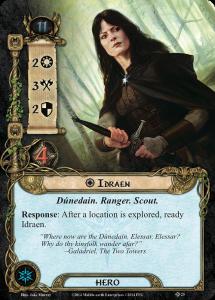 At least the Ringmaker cycle did give some scope to allow the players to tech against all these nasty locations. A new hero, Idraen was probably the first to interact directly with locations, and her ability to ready after a location was explored allowed long-neglected cards like Strength of Will to make a come-back: if you can travel to a location which only needs 2 more progress, this card essentially allows her to explore it for free.
At least the Ringmaker cycle did give some scope to allow the players to tech against all these nasty locations. A new hero, Idraen was probably the first to interact directly with locations, and her ability to ready after a location was explored allowed long-neglected cards like Strength of Will to make a come-back: if you can travel to a location which only needs 2 more progress, this card essentially allows her to explore it for free. This card always felt a bit lacklustre to me: it draws my mind back to a “Strider” custom hero I made several years ago, a Spirit version of Aragorn who acted as a Thalin for locations, placing 1 progress on each location revealed whilst he was questing. Given the size of modern locations, I really don’t think that the card would have been overpowered if it had done this, and my lack of enthusiasm is unlikely to change, but it is at least cheap enough that if you’ve got a scout who’s going to be questing every round, there’s little reason not to slap it on her.
This card always felt a bit lacklustre to me: it draws my mind back to a “Strider” custom hero I made several years ago, a Spirit version of Aragorn who acted as a Thalin for locations, placing 1 progress on each location revealed whilst he was questing. Given the size of modern locations, I really don’t think that the card would have been overpowered if it had done this, and my lack of enthusiasm is unlikely to change, but it is at least cheap enough that if you’ve got a scout who’s going to be questing every round, there’s little reason not to slap it on her.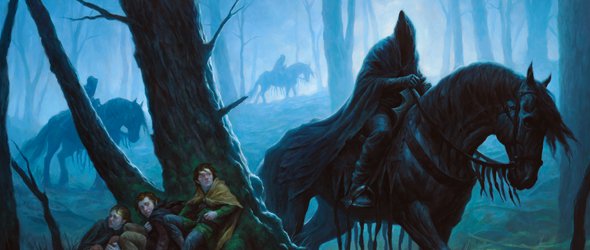
 There are quite a lot of locations in the first quest, and this becomes particularly problematic when you reach the final stage and are attempting to travel to the Buckleberry Ferry – this unique location is immune to player card effects, and can only be travelled to if there are no other locations in play. In our experience, this can lead to round after round where you smash the questing, but can’t clear enough locations in 1 go to be allowed to travel (there is some help available from the quest card, but in 4-player it’s often not enough).
There are quite a lot of locations in the first quest, and this becomes particularly problematic when you reach the final stage and are attempting to travel to the Buckleberry Ferry – this unique location is immune to player card effects, and can only be travelled to if there are no other locations in play. In our experience, this can lead to round after round where you smash the questing, but can’t clear enough locations in 1 go to be allowed to travel (there is some help available from the quest card, but in 4-player it’s often not enough).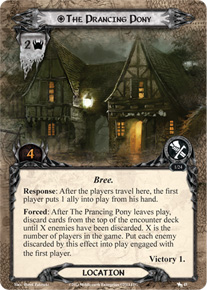 Moving on to Bree, there are more unique locations, starting with The Prancing Pony and proceeding on through Midgewater, to finally end up at Weathertop itself. The unique locations give shape to the overall narrative of the quest, and have fairly powerful effects, both good and bad. This pattern is continued in the Flight to the Ford, where the Last Bridge and Ford of the Bruinen draw directly from the books for their abilities.
Moving on to Bree, there are more unique locations, starting with The Prancing Pony and proceeding on through Midgewater, to finally end up at Weathertop itself. The unique locations give shape to the overall narrative of the quest, and have fairly powerful effects, both good and bad. This pattern is continued in the Flight to the Ford, where the Last Bridge and Ford of the Bruinen draw directly from the books for their abilities. That said, the decision-making in this box often felt very constricted: many of the unique locations are put into play by quest effects, or need to be explored before the stage can be completed. As such, whilst we see these iconic locations as we go along, there’s actually fairly limited interaction with them – you travel when you have to, and explore them once you’ve mustered enough progress. That’s about it.
That said, the decision-making in this box often felt very constricted: many of the unique locations are put into play by quest effects, or need to be explored before the stage can be completed. As such, whilst we see these iconic locations as we go along, there’s actually fairly limited interaction with them – you travel when you have to, and explore them once you’ve mustered enough progress. That’s about it. Box 2 (for book 2, none of this nonsense about Lord of the Rings being a Trilogy) felt to me like they’d managed to strike more of a balance with the locations – the fact that we had already spent so much time in Moria meant that the designers had already had plenty of chance to play around with mechanics that might represent the Doors of Durin or the Bridge of Khazad-Dum, and these certainly felt like the refined version. The first quest out of Rivendell could well prove to be the death of the hobbits, as damage is scattered across locations, triggering in turn cascades of nasty effects.
Box 2 (for book 2, none of this nonsense about Lord of the Rings being a Trilogy) felt to me like they’d managed to strike more of a balance with the locations – the fact that we had already spent so much time in Moria meant that the designers had already had plenty of chance to play around with mechanics that might represent the Doors of Durin or the Bridge of Khazad-Dum, and these certainly felt like the refined version. The first quest out of Rivendell could well prove to be the death of the hobbits, as damage is scattered across locations, triggering in turn cascades of nasty effects.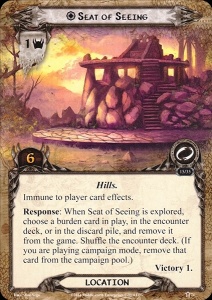 The final quest returns to the stacked sequence of unique locations, and gives you very little choice over what to do in the early rounds, along with providing heavy punishment for certain deck-types. Whilst the initial stages can get annoying though, I’m generally prepared to give them a pass, because I’m such a fan of the way the latter part of the quest is done: I really like the multiple staging areas, and the way cards move between them, it felt like a clever way of representing a party scattered across a fast-flowing river, and made for an enjoyable experience. In campaign mode, the Seat of Seeing adds another fun element of decision-making, as you have to weigh whether to stall the quest a little longer in an attempt to get rid of those burdens.
The final quest returns to the stacked sequence of unique locations, and gives you very little choice over what to do in the early rounds, along with providing heavy punishment for certain deck-types. Whilst the initial stages can get annoying though, I’m generally prepared to give them a pass, because I’m such a fan of the way the latter part of the quest is done: I really like the multiple staging areas, and the way cards move between them, it felt like a clever way of representing a party scattered across a fast-flowing river, and made for an enjoyable experience. In campaign mode, the Seat of Seeing adds another fun element of decision-making, as you have to weigh whether to stall the quest a little longer in an attempt to get rid of those burdens. Overall, I think the first 2 Saga Boxes for Lord of the Rings did a really good job of capturing the flavour of the books, and the latter box in particular managed to convert them into enjoyable quests to play. Although these two boxes relied quite heavily on having cards that were unique to each quest, I actually thought that some of the most interesting locations came in the sets that were shared across multiple quests, The Old Road and Pathless Country. Both of these offered fairly low-to-middling stat-lines, but combined them with effects that forced players to make choices – The Old Road can be gone in a heartbeat, if you take on the peril of another Burden. The Pathless County can be left and tracked over the course of several rounds, but it will take a long time, due to those conditional extra progress tokens – this type of mechanic, where players are given meaningful choices definitely scores them points in my book.
Overall, I think the first 2 Saga Boxes for Lord of the Rings did a really good job of capturing the flavour of the books, and the latter box in particular managed to convert them into enjoyable quests to play. Although these two boxes relied quite heavily on having cards that were unique to each quest, I actually thought that some of the most interesting locations came in the sets that were shared across multiple quests, The Old Road and Pathless Country. Both of these offered fairly low-to-middling stat-lines, but combined them with effects that forced players to make choices – The Old Road can be gone in a heartbeat, if you take on the peril of another Burden. The Pathless County can be left and tracked over the course of several rounds, but it will take a long time, due to those conditional extra progress tokens – this type of mechanic, where players are given meaningful choices definitely scores them points in my book.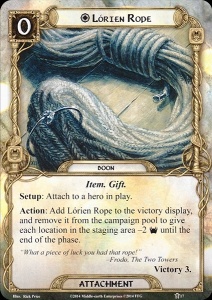 One thing that the Fellowship of the Rings boxes didn’t really offer a lot of, was new cards for players to deal with locations – in fact, there was nothing within the standard card-pool that would allow us to manipulate threat, progress, or effects on locations. The “Lorien Rope” Boon provided a powerful effect, reducing the threat of every location in the staging area by 2 for a round, but to trigger it, you had to remove the card from the campaign pool, so it wasn’t something you could really rely on, even in campaign mode (and wasn’t available at all outside of it).
One thing that the Fellowship of the Rings boxes didn’t really offer a lot of, was new cards for players to deal with locations – in fact, there was nothing within the standard card-pool that would allow us to manipulate threat, progress, or effects on locations. The “Lorien Rope” Boon provided a powerful effect, reducing the threat of every location in the staging area by 2 for a round, but to trigger it, you had to remove the card from the campaign pool, so it wasn’t something you could really rely on, even in campaign mode (and wasn’t available at all outside of it).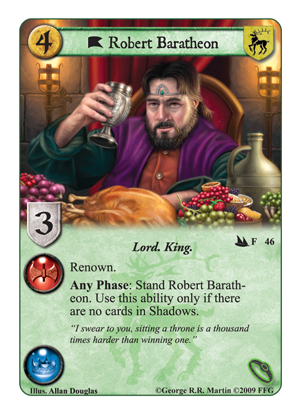
 I bought the Lord of the Rings LCG the day it came out, and loved it. We made some stupid mistakes to begin with (counting the threat of engaged enemies was a big one), but gradually we figured out what we were doing. I played it solo, with my wife, and with groups of friends in 3 and 4-player. For years I bought every product that they made for this game, although after the first few cycles, I gave up on the Nightmare decks.
I bought the Lord of the Rings LCG the day it came out, and loved it. We made some stupid mistakes to begin with (counting the threat of engaged enemies was a big one), but gradually we figured out what we were doing. I played it solo, with my wife, and with groups of friends in 3 and 4-player. For years I bought every product that they made for this game, although after the first few cycles, I gave up on the Nightmare decks. There is some mitigation to this: Beregond, Cirdan and Eowyn have all brought success for my wife and other players in our games, and Elfhelm has attempted several quests, even if he’s not actually managed to secure victory.
There is some mitigation to this: Beregond, Cirdan and Eowyn have all brought success for my wife and other players in our games, and Elfhelm has attempted several quests, even if he’s not actually managed to secure victory. Arkham Horror the card game is also a cooperative LCG from Fantasy Flight, and it shares a designer along with several recognisable features with LotR. That said, there is also a lot about it that’s different.
Arkham Horror the card game is also a cooperative LCG from Fantasy Flight, and it shares a designer along with several recognisable features with LotR. That said, there is also a lot about it that’s different.
 It’s quite easy to see the mark of LotR in Arkham – the way locations are done in this game definitely feels like it got a test-run in the Dreamchaser cycle, and the end result is a more polished, cleaner implementation – hopefully in the future, we’ll be able to see the favour returned: concepts piloted in Arkham, and then put to use in LotR. Game of Thrones LCG recently hosted their
It’s quite easy to see the mark of LotR in Arkham – the way locations are done in this game definitely feels like it got a test-run in the Dreamchaser cycle, and the end result is a more polished, cleaner implementation – hopefully in the future, we’ll be able to see the favour returned: concepts piloted in Arkham, and then put to use in LotR. Game of Thrones LCG recently hosted their 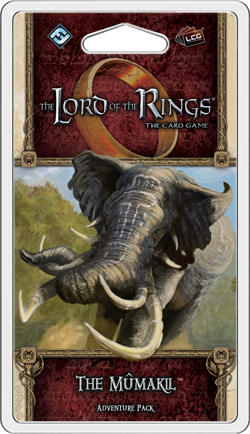
 Ostensibly the biggest change in this cycle came with the new mechanics: Battle and Siege, which turned the game on its head as characters were required to quest using their Attack or Defence respectively, rather than their traditional Willpower. It was also, perhaps a last hurrah for the idea that this game was primarily based around Spheres of Influence, rather than the “Tribal” themes which drew together decks of mostly Dwarves, Elves, Rohirrim, or Gondor, as the player-card pool received a series of cards which supported players running Mono-sphere decks.
Ostensibly the biggest change in this cycle came with the new mechanics: Battle and Siege, which turned the game on its head as characters were required to quest using their Attack or Defence respectively, rather than their traditional Willpower. It was also, perhaps a last hurrah for the idea that this game was primarily based around Spheres of Influence, rather than the “Tribal” themes which drew together decks of mostly Dwarves, Elves, Rohirrim, or Gondor, as the player-card pool received a series of cards which supported players running Mono-sphere decks.
 Starting Active Locations with unpleasant effects were also a big thing in this cycle. Whereas earlier in the game’s life we had tended to see these locations start in the staging area, now it became more common for their effect to be in play from the word go – whether that be the
Starting Active Locations with unpleasant effects were also a big thing in this cycle. Whereas earlier in the game’s life we had tended to see these locations start in the staging area, now it became more common for their effect to be in play from the word go – whether that be the  The Against the Shadow cycle itself saw a wide variety of locations, any many of them reflected that quest’s unique: Underworld in the Steward’s Fear, Villagers in Encounter at Amon Din, Hidden Cards in The Blood of Gondor. Even when the keyword itself was not directly carried across, there was a stronger sense of thematic tie-in in this cycle: for example all of the resource denial in Druadan Forest to complement the Prowl Mechanic, or the wat that locations in The Morgul Vale tried to add progress to To The Tower, or else simply flung things back to the staging area in order to slow the players down.
The Against the Shadow cycle itself saw a wide variety of locations, any many of them reflected that quest’s unique: Underworld in the Steward’s Fear, Villagers in Encounter at Amon Din, Hidden Cards in The Blood of Gondor. Even when the keyword itself was not directly carried across, there was a stronger sense of thematic tie-in in this cycle: for example all of the resource denial in Druadan Forest to complement the Prowl Mechanic, or the wat that locations in The Morgul Vale tried to add progress to To The Tower, or else simply flung things back to the staging area in order to slow the players down. The overall effect of this was to make locations something that was much more of an issue than in earlier cycles – you certainly could just track away most of the places you went in the Steward’s Fear, but if you did so, there was a very real danger of getting suddenly ambushed by a large number of enemies from the Underworld deck. If you didn’t come with ways of dealing with the Druadan Forest, the Woses and their accompanying treacheries suddenly took on a rather fearsome aspect, with Threats of X and high archery totals. Encounter at Amon Din was largely an exercise in exploring as many locations as possible as fast as possible: Mostly low-threat, high progress, they look like ideal targets for the Northern Tracker, were it not for the Villagers burning alive round-by-round.
The overall effect of this was to make locations something that was much more of an issue than in earlier cycles – you certainly could just track away most of the places you went in the Steward’s Fear, but if you did so, there was a very real danger of getting suddenly ambushed by a large number of enemies from the Underworld deck. If you didn’t come with ways of dealing with the Druadan Forest, the Woses and their accompanying treacheries suddenly took on a rather fearsome aspect, with Threats of X and high archery totals. Encounter at Amon Din was largely an exercise in exploring as many locations as possible as fast as possible: Mostly low-threat, high progress, they look like ideal targets for the Northern Tracker, were it not for the Villagers burning alive round-by-round. Probably the most notable Quest of the Cycle from a location perspective though, was Assault on Osgiliath. This was ostensibly a street-fight, a back-and-forth tussle to take the city, street by street, location by location. When a location was explored, the players took control of it, potentially bringing a benefit, but more commonly just another condition they needed to watch out for which could see that control lost if they left an attack undefended or a character was destroyed.
Probably the most notable Quest of the Cycle from a location perspective though, was Assault on Osgiliath. This was ostensibly a street-fight, a back-and-forth tussle to take the city, street by street, location by location. When a location was explored, the players took control of it, potentially bringing a benefit, but more commonly just another condition they needed to watch out for which could see that control lost if they left an attack undefended or a character was destroyed. The overall objective for Assault on Osgiliath was to control all the Osgiliath locations at the end of the round and, as originally printed, it was rather broken – you could
The overall objective for Assault on Osgiliath was to control all the Osgiliath locations at the end of the round and, as originally printed, it was rather broken – you could  The Heirs deluxe box probably contained the most direct attempt at location control, A Watchful Peace – this was a spirit event which allowed players to return innocuous locations to the top of the encounter deck after they left play – interesting, but hardly powerful.
The Heirs deluxe box probably contained the most direct attempt at location control, A Watchful Peace – this was a spirit event which allowed players to return innocuous locations to the top of the encounter deck after they left play – interesting, but hardly powerful.
 As we’ve played this cycle mostly 2-player with a little bit of solo, it’s generally been about choosing a single escort for the Dreamchaser, and the choice has almost always been Narelenya. The once-per-round cost reduction of an ally is a really powerful effect in almost any deck, and it’s particularly true of my wife’s current Gondor deck, and of course, my tried-and-tested solo deck: Play as many Dwarves as you can.
As we’ve played this cycle mostly 2-player with a little bit of solo, it’s generally been about choosing a single escort for the Dreamchaser, and the choice has almost always been Narelenya. The once-per-round cost reduction of an ally is a really powerful effect in almost any deck, and it’s particularly true of my wife’s current Gondor deck, and of course, my tried-and-tested solo deck: Play as many Dwarves as you can. On the flip side, threat reduction is nice, as offered by Silver Wing, but is the +1 attack per hero worth it? Potentially with the difficulty of Corsair bashing this is one we should investigated in more detail but I can’t recall ever using this solo or 2-player. Perhaps a Lorgaron deck might be able to get better mileage out of, but for us it never felt worthwhile. It would actually be quite nice if you could leave out the Dreamchaser, and have Dawn Star and Silver Wing balance each other out in solo, but sadly this is never an option.
On the flip side, threat reduction is nice, as offered by Silver Wing, but is the +1 attack per hero worth it? Potentially with the difficulty of Corsair bashing this is one we should investigated in more detail but I can’t recall ever using this solo or 2-player. Perhaps a Lorgaron deck might be able to get better mileage out of, but for us it never felt worthwhile. It would actually be quite nice if you could leave out the Dreamchaser, and have Dawn Star and Silver Wing balance each other out in solo, but sadly this is never an option. Most Ship enemies had a few things in common – big stats, the “Boarding” Keyword, and limited interaction with other player-card types.
Most Ship enemies had a few things in common – big stats, the “Boarding” Keyword, and limited interaction with other player-card types. Beyond that though, it just made the burden of combat feel too uneven. We’ve played quite a few quests this cycle combining a fight-y Gondor deck and a Spirit Questing deck – once the Spirit deck has properly got set up, it has some decent combat potential (Idraen and Lanwyn are amongst heroes, and it also runs ally Glorfindel, Northern Trackers and Rhovanion Outriders) – against a normal enemy or two, it can handle a fight. What it can’t deal with is a massive boat AND a few random pirate enemies thrown in on top, especially when many of those pirates have resource-stealing mechanics which make them more and more powerful if you can’t kill them in a single round. Even for the Gondor deck, defending a ship with their ship, defending a handful of Corsairs and being expected to strike back again, is a major problem – if you don’t have Boromir the Steward of Gondorian Fire set up, along with a bucketload of threat-reduction, it’s just not feasible, and that’s coming from a deck that’s designed to be able to handle combat.
Beyond that though, it just made the burden of combat feel too uneven. We’ve played quite a few quests this cycle combining a fight-y Gondor deck and a Spirit Questing deck – once the Spirit deck has properly got set up, it has some decent combat potential (Idraen and Lanwyn are amongst heroes, and it also runs ally Glorfindel, Northern Trackers and Rhovanion Outriders) – against a normal enemy or two, it can handle a fight. What it can’t deal with is a massive boat AND a few random pirate enemies thrown in on top, especially when many of those pirates have resource-stealing mechanics which make them more and more powerful if you can’t kill them in a single round. Even for the Gondor deck, defending a ship with their ship, defending a handful of Corsairs and being expected to strike back again, is a major problem – if you don’t have Boromir the Steward of Gondorian Fire set up, along with a bucketload of threat-reduction, it’s just not feasible, and that’s coming from a deck that’s designed to be able to handle combat.